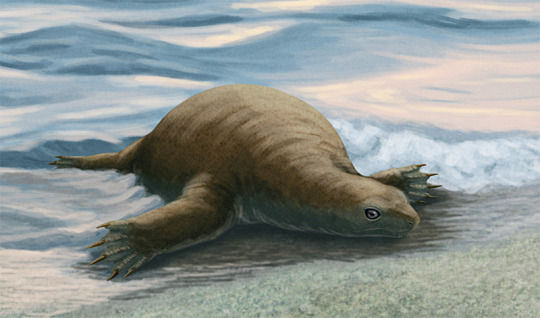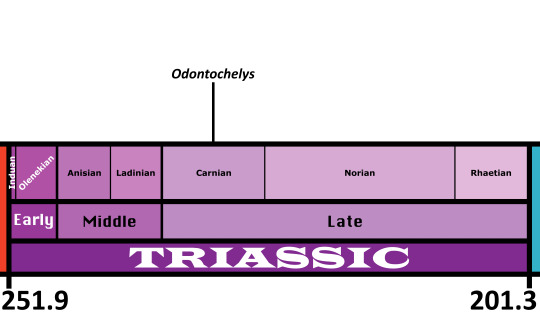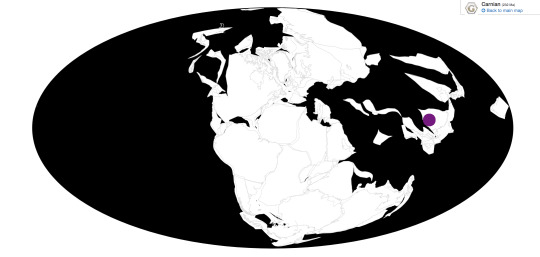#triassic madnes
Explore tagged Tumblr posts
Text
Odontochelys semitestacea

By @alphynix
Etymology: Toothed Turtle
First Described By: Lie et al., 2008
Classification: Biota, Archaea, Proteoarchaeota, Asgardarchaeota, Eukaryota, Neokaryota, Scotokaryota, Opimoda, Podiata, Amorphea, Obazoa, Opisthokonta, Holozoa, Filozoa, Choanozoa, Animalia, Eumetazoa, Parahoxozoa, Bilateria, Nephrozoa, Deuterostomia, Chordata, Olfactores, Vertebrata, Craniata, Gnathostomata, Eugnathostomata, Osteichthyes, Sarcopterygii, Rhipidistia, Tetrapodomorpha, Eotetrapodiformes, Elpistostegalia, Stegocephalia, Tetrapoda, Reptiliomorpha, Amniota, Sauropsida, Eureptilia, Romeriida, Diapsida, Neodiapsida, Sauria, Archosauromorpha?, Archelosauria, Pantestudines, Odontochelyidae
Time and Place: Around 232 million years ago, in the Carnian age of the Late Triassic

Odontochelys is known from the Lower Member of the Xiaowa Formation of China, commonly known as the Guanling Fauna

Physical Description: Odontochelys is one of the earliest known turtles - preceded by one, possibly two, precursors other than stem members of the family group - and it showcases how this extremely unique group managed to evolve in the chaos that was the Triassic Explosion. It was simultaneously similar to and very different from living turtles, a true transitional organism. Like other reptiles, it had teeth embedded in its jaws, rather than the toothless beak found in turtle mouths. Like turtles, it had the lower plastron extending from its ribs, but unlike living turtles it had no upper shell - instead, it just had widened ribs and no bony shell around its body. The ribs and the vertebrae were put together differently from modern turtles as well, and its skull was more stretched out compared to its living relatives. It didn’t have fused tail bones, and its scapulae were very different from living turtles. It had short limbs and long, thick fingers, as well as a decently sized shell. It was about forty centimeters long from snout to tail tip.
Diet: The diet of Odontochelys is fairly uncertain, despite us having its teeth; though they are small and peg like, we can’t really extrapolate a function since we don’t actually know its precise ecology! They may have been used for stripping plants, but it’s also possible they were used to chipp up algae and other aquatic water plants, or even invertebrates! So, more research there is clearly needed.
Behavior: The life history of Odontochelys is actually a big mystery. It was found in a marine environment, leading initial studies to indicate it was marine. However, it had the hands of a fresh water organism, including fresh water turtles today. Furthermore, studies of other early turtles indicate that turtles first arose on the land, rather than in the water, and later groups would adapt to water life; the limbs of Odontochelys share similarities with tortoises and support a terrestrial lifestyle. So, the ecology of Odontochelys has been a constant battle. That said, there is some evidence that it was actually marine - and may represent an early experiment in ocean life by turtles. One fossil of Odontochelys indicates that it had completely messed up shoulder bones, likely due to a problem in life rather than destruction of the fossil. This pattern resembles decompression sickness, aka the bends, aka the condition caused by a diving animal coming up much too fast from a lower depth. Modern turtles have complex behavioral adaptations to avoid the bends, so Odontochelys may be an early experiment in marine life in a group mostly adapted for terrestrial life. In this transition to ocean life, it not only lacked better physical adaptations for the ocean, but also better behavioral ones, and was stricken with the bends on its trip back to the surface. So, as we try to determine its ecology and behavior, these clued paint a rich tapestry of the world’s most transitional turtle. A pioneer!
Ecosystem: Odontochelys was found in - and thus, the null hypothesis is that it lived in - an ocean environment near the coast of the Tethys sea. This was a deep, open ocean - pelagic, hence the bends and problems Odontochelys faced trying to deal with the ocean. It was a very fertile ecosystem as well, with a variety of Triassic marine animals showcasing the rapid evolution of these groups. Among the invertebrates, there were many different types of Ammonites, plenty of bivalves, brachiopods, and crinoids & sea cucumbers as well. Still, the fascinating part of the ecosystem was the sheer number of marine reptiles. There were Thalattosaurs such as Anshusaurus and Xinpusaurus; Placodonts like Psephochelys and Sinocyamodus; and Ichthyosaurs like Qianicthyosaurus, Guizhouichthyosaurus, Guanlingsaurus, and Callawayia. One of many beautiful deposits of marine animals from this Period - and the many Ichthyosaurs would have been major predators of the relative n00b Odontochelys.
Other: Odontochelys also just looks really weird because it basically looks like your usual turtle except it doesn’t have a freaking shell so here we are with this oddity. It’s transitional in shape, transitional in ecology, transitional in behavior, and just. What the heck. What the heck, Odontochelys. If you need more proof for evolution despite knowing about the dinosaur - bird transition, have I got a friend for you.
~ By Meig Dickson
Sources Under the Cut
Anquetin, J. 2012. Reassessment of the phylogenetic interrelationships of basal turtles (Testudinata). Journal of Systematic Palaeontology 10(1):3-45.
Bradley Shaffer, H., E. McCartney-Melstad, T. J. Near, G. G. Mount, P. Q. Spinks. 2017. Phylogenomic analyses of 539 highly informative loci dates a fully resolved time tree for the major clades of living turtles (Testudines). Molecular Phylogenetics and Evolution 115: 7 - 15.
Feldmann, R. M., C. E. Schweitzer, S. Hu, J. Huang, Q. Zhang, C. Zhou, W. Wen, T. Xie, E. P. Maguire. 2017. A new Middle Triassic (Anisian) cyclidan crustacean from the Luoping Biota, Yunnan Province, China: morphologic and phylogenetic insights. Journal of Crustacean Biology 37 (4): 406 - 412.
Gilbert, S. F. 2007. How the turtle gets its shell. Biology of Turtles: The Structures to Strategies of Life.
Heiss, E. 2010. Functionality and plasticity of turtle-feeding with special emphasis on oropharyngeal structures. Universitat Wien Doctoral Dissertation.
Hess, H., W. Etter, and H. Hagdorn. 2016. Roveacrinida (Crinoidea) from Late Triassic (early Carnian) black shales of Southwest China. Swiss Journal of Paleontology 135(2):249-274.
Joyce, W. G. 2015. The origin of turtles: A paleontological perspective. Journal of Experimental Zoology Part B: Molecular and Developmental Evolution 324 (3): 181 - 193.
Lee, M. S. Y. 2013. Turtle origins: Insights from phylogenetic retrofitting and molecular scaffolds. Journal of Evolutionary Biology 26 (12): 2729 - 2738.
Lemell, P., N. Natchev, C. J. Beisser, E. Heiss. 2019. Feeding in Turtles: Understanding Terrestrial and Aquatic Feeding in a Diverse but Monophyletic Group. Feeding in Vertebrates: 611 - 642.
Li, C., and O. Rieppel. 2002. A new cyamodontid placodont from Triassic of Guizhou, China. Chinese Science Bulletin 47(5):403-407.
Li, C., X. C. Wu, O. Rieppel, L. T. Wang, and L. J. Zhao. 2008. An ancestral turtle from the Late Triassic of southwestern China. Nature 456:497-501.
Lu, H., D.-Y. Jiang, R. Motani, P.-G. Ni, Z.-Y. Sun, A. Tintori, S.-Z. Xiao, M. Zhou, C. Ji, W.-L. Fu. 2018. Middle Triassic Xingyi Fauna: Showing turnover of marine reptiles from coastal to oceanic environments. Palaeoworld 27 (1): 107 - 116.
Luo, M., Y.-M. Gong, G. R. Shi, Z.-Q. Chen, J. Huang, S. Hu, X. Feng, Q. Zhang, C. Zhou, W. Wen. 2018. Palaeoecological Analysis of Trace Fossil Sinusichnus sinuosus from the Middle Triassic Guanling Formationin Southwestern China. Journal of Earth Science 29: 854 - 863.
Meredith, R. W., J. Gatesy, M. S. Springer. Molecular decay of enamel matrix protein genes in turtles and other edentulous amniotes. BMC Evolutionary Biology 13: 20.
Neenan, J. M., N. Klein, T. M. Scheyer. 2013. European origin of placodont marine reptiles and the evolution of crushing dentition in Placodontia. Nature Communications 4: 1621.
Nicholls, E. L., C. Wei, and M. Manabe. 2002. New material of Qianichthyosaurus Li, 1999 (Reptilia, Ichthyosauria) from the Late Triassic of southern China, and implications for the distribution of Triassic icthyosaurs. Journal of Vertebrate Paleontology 22(4):759-765.
Reisz, R. R., J. J. Head. 2008. Palaeontology: Turtle origins out to sea. Nature 456 (7221): 450 - 451.
Rothschild, B. M., V. Naples. 2015. Decompression syndrome and diving behavior in Odontochelys, the first turtle. Acta Palaeontologica Polonica 60 (1): 163 - 167.
Schoch, R. R., H.-D. Sues. 2015. A Middle Triassic stem-turtle and the evolution of the turtle body plan. Nature 523 (7562): 584 - 587.
Shang, Q.-H., and C. Li. 2009. On the occurrence of the ichthyosaur Shastasaurus in the Guanling biota (Late Triassic), Guizhou, China. Vertebrata PalAsiatica 47(3):178-193.
Vermeij, G. J., R. Motani. 2017. Land to sea transitions in vertebrates: the dynamics of colonization. Paleobiology 44 (2): 237 - 250.
Wang, X., G. H. Bachmann, H. Hagdorn, P. M. Sanders, G. Cuny, X. Chen, C. Wang, L. Chen, L. Cheng, F. Meng, and G. Xu. 2008. The Late Triassic black shales of the Guanling area, Guizhou province, south-west China: a unique marine reptile and pelagic crinoid fossil lagerstätte. Palaeontology 51(1):27-61.
Wang, X., X. Chen, C. Wang, L. Cheng. 2009. The Triassic Guanling Fossil Group - A Key GeoPark from a barren mountain, Guizhou Province, China. Notebooks on Geology 3: Chapter 2: 11 - 28.
328 notes
·
View notes
Text
Round Two: Match Twelve
Lagerpeton

By @quetzalpali-art
Versus

By @quetzalpali-art
Daemonosaurus
Click on the above links to refresh your memory about these animals! And feel free to use this post to debate and argue on what people should vote for!
The Official Tag for Triassic Madness is “#Triassic March Madness”! Be sure to look there for posts!
#Triassic March Madness#triassic madnes#Triassic#Palaeoblr#TMM#Round Two#Round Two Match Twelve#Daemonosaurus#Lagerpeton
26 notes
·
View notes
Text
Round Two: Match Fourteen
Lystrosaurus

By @thewoodparable
Versus

By @drawingwithdinosaurs
Drepanosaurus
Click on the above links to refresh your memory about these animals! And feel free to use this post to debate and argue on what people should vote for!
The Official Tag for Triassic Madness is “#Triassic March Madness”! Be sure to look there for posts!
#Triassic March Madnes#Triassic Madness#Triassic#Palaeoblr#TMM#Lystrosaurus#Drepanosaurus#Round Two#Round Two Match Fourteen
178 notes
·
View notes
Text
Vote Drepanosaurus for being a monkey but way cooler
Round Two: Match Fourteen
Lystrosaurus

By @thewoodparable
Versus

By @drawingwithdinosaurs
Drepanosaurus
Click on the above links to refresh your memory about these animals! And feel free to use this post to debate and argue on what people should vote for!
The Official Tag for Triassic Madness is “#Triassic March Madness”! Be sure to look there for posts!
#Triassic March Madnes#Triassic Madness#Triassic#Palaeoblr#TMM#Lystrosaurus#Drepanosaurus#Round Two#Round Two Match Fourteen
178 notes
·
View notes